Travel Journal: (Alaska Highway - Dawson Creek, BC to Fairbanks, AK) |

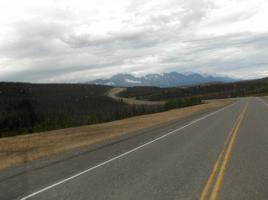 The
Alaska Highway is much better than the monster car breaking road
it is often made out to be. Most of the Alaska Highway (over 90%)
is excellent and compares very well with any good two-lane road
in the United States. It appears to be much improved over the
years and is mostly very well maintained.
The
Alaska Highway is much better than the monster car breaking road
it is often made out to be. Most of the Alaska Highway (over 90%)
is excellent and compares very well with any good two-lane road
in the United States. It appears to be much improved over the
years and is mostly very well maintained.  It
is fairly smooth, has very few steep hills and very few sharp
corners. The speed limit on most of it is 100 km/hr (62 mph).
The shoulders are fairly wide almost all the time and th
It
is fairly smooth, has very few steep hills and very few sharp
corners. The speed limit on most of it is 100 km/hr (62 mph).
The shoulders are fairly wide almost all the time and th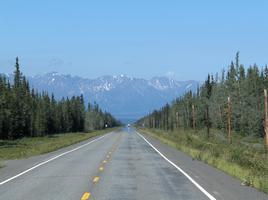 e
trees along the road are trimmed back further than anywhere I
have seen (maybe 100m wide side to side most of the time) which
gives excellent visibility ahead, even around many of the gentle
sweeping corners. There is very little traffic along the road.
Often the closest car or RV was at least a mile away, which could
be seen on one of the many longer straight sections of the road.
Most of the time, it was very easy to pass slower vehicles or
be passed by faster vehicles (mostly the latter of the two).
e
trees along the road are trimmed back further than anywhere I
have seen (maybe 100m wide side to side most of the time) which
gives excellent visibility ahead, even around many of the gentle
sweeping corners. There is very little traffic along the road.
Often the closest car or RV was at least a mile away, which could
be seen on one of the many longer straight sections of the road.
Most of the time, it was very easy to pass slower vehicles or
be passed by faster vehicles (mostly the latter of the two).
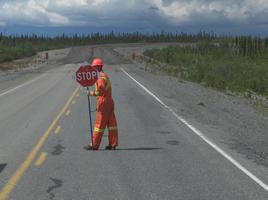 About 2% to 3% of the road is actively under
construction, with much of that alongside the current road. The
worst conditions were from Haines Junction to Beaver Creek, with
multiple areas of construction.
About 2% to 3% of the road is actively under
construction, with much of that alongside the current road. The
worst conditions were from Haines Junction to Beaver Creek, with
multiple areas of construction.  It
probably was only about 30 miles total under construction, but
it seemed like a lot. The flagger people were very friendly in
Canada, often walking back to say "hi" to each driver
and explain what is up ahead. This was not true in Alaska, as
those flaggers just did their job of holding the sign. The main
problem with construction sections of road is that they tend to
bunch traffic up for a while. At one busier place along the road
maybe 20 cars grouped up together during a 5 minute wait. At other
places, only about 5 cars went through after a 5 minute wait.
It sometimes takes about 20 miles to unbunch the larger group
of traffic, with some vehicles exiting at various points and others
speeding farther ahead. Once it thins some and you get past the
one old couple that is slower than the rest, the traffic is back
to minimal.
It
probably was only about 30 miles total under construction, but
it seemed like a lot. The flagger people were very friendly in
Canada, often walking back to say "hi" to each driver
and explain what is up ahead. This was not true in Alaska, as
those flaggers just did their job of holding the sign. The main
problem with construction sections of road is that they tend to
bunch traffic up for a while. At one busier place along the road
maybe 20 cars grouped up together during a 5 minute wait. At other
places, only about 5 cars went through after a 5 minute wait.
It sometimes takes about 20 miles to unbunch the larger group
of traffic, with some vehicles exiting at various points and others
speeding farther ahead. Once it thins some and you get past the
one old couple that is slower than the rest, the traffic is back
to minimal.
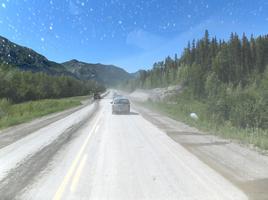 When the road was not under construction,
it had some patches already applied which was dusty and bumpy.
We washed our car in Fairbanks, but our RV is still very dirty
from all the construction and repairs we traveled over. We did
not see any major frost heaves on this trip. Since it is late
June, one explanation is that most of them have been worked on
earlier in the season and are now those dusty patched places.
The places to watch for are well marked by either flags in buckets
or cones along side the road, but most of the time those marked
sections were just a little bit bumpy. The biggest problem with
the patched areas is the cloud of dust that affects visibility
and coats the vehicles.
When the road was not under construction,
it had some patches already applied which was dusty and bumpy.
We washed our car in Fairbanks, but our RV is still very dirty
from all the construction and repairs we traveled over. We did
not see any major frost heaves on this trip. Since it is late
June, one explanation is that most of them have been worked on
earlier in the season and are now those dusty patched places.
The places to watch for are well marked by either flags in buckets
or cones along side the road, but most of the time those marked
sections were just a little bit bumpy. The biggest problem with
the patched areas is the cloud of dust that affects visibility
and coats the vehicles.
Overall, the quality of the road is not a reason to avoid driving the Alaska Highway. The length of it might be though. It is mile after mile, or more accurately kilometer after kilometer of very similar scenery. It is pretty, but a lot the same. The road generally follows very wide valleys of trees, trees, and more trees.
Gas cost money, lots of it in places that are more remote. We paid $2.04/gal in Cheyenne on the day we left home and passed through there. Prices in Montana were around $2.20/gal. In Canada, prices ranged from $0.845/liter (Canadian money) in Lethbridge and Calgary, and gradually worked up to $1.059/liter in some places along the Alaskan Highway. When we got into Alaska, the price dropped back to $2.319/gal in Tok, and $2.229/gal in Fairbanks.
At the time of this writing, the exchange rate is about $1.00 USD equals $1.22 CDN. I don't know what exchange rate the credit card companies give. Using this info, CDN $0.845/liter works out to USD $2.62/gal and CDN $1.059/liter equals USD $3.29/gal. So much for the budget.
Buy gas in the USA if at all possible. :-)
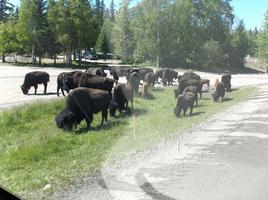
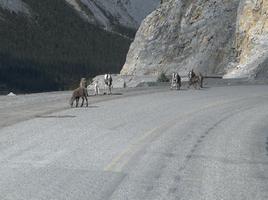 One
of the highlights during the trip was seeing some wildlife. There
were some mountain sheep down along the road at one point. We
think they were licking the salt off the road, and were so into
what they were doing that cars passing by very closely didn't
bother them. In another place, there were bison right next to
the road. The one moose that has been seen was about a half mile
away. We did not see any bears while traveling the Alaska Highway.
One
of the highlights during the trip was seeing some wildlife. There
were some mountain sheep down along the road at one point. We
think they were licking the salt off the road, and were so into
what they were doing that cars passing by very closely didn't
bother them. In another place, there were bison right next to
the road. The one moose that has been seen was about a half mile
away. We did not see any bears while traveling the Alaska Highway.
The second day on the Alaska Highway started out like any other, but we heard a couple "thunks" from the car, followed by the car not following as steadily as previous days. After pulling over, Jerry checked it out and eventually determined that the safety cable was pulled against the locking pin of the tow bar. This caused the tow bar to not lock down, and allow the car to weave a little bit. Once this was straightened out the car followed properly again.
The main thing Watson Lake is known
for is their "Sign Forest". This is a bunch of 4x4
posts about 3 meters tall where people add signs of their choice.
It started along time ago when construction workers indicated
how far it was back to their home towns. Now it is mostly people
posted either who they are or the place they come for.  We
saw that someone had posted a "Fort Collins, CO" sign
earlier this year. There must be thousands of signs and they appear
to be removing most of the older ones, as we could mostly only
find signs with dates over the past 5 or 10 years. These pictures
probably show well under 10% of the signs that are here in this
"forest".
We
saw that someone had posted a "Fort Collins, CO" sign
earlier this year. There must be thousands of signs and they appear
to be removing most of the older ones, as we could mostly only
find signs with dates over the past 5 or 10 years. These pictures
probably show well under 10% of the signs that are here in this
"forest".
We also viewed the presentation at the Northern Lights Centre. This is sort of a cross between a omni screen program and a planetarian program. The show was about a hour long and was pretty good. It gave a good perspective on how big the known universe is and then a show of Northern lights filmed in the Yukon and played with soothing music. It was dark in there and with the music playing, sleep was almost too tempting.
The showers at the place we stayed at in Watson Lake required 2 "Loonies" for "5 minutes" of shower time. In previous places, we have paid $1 for 7 or 8 minutes, but this place was faster and more expensive. In the previous places there was plenty of time, so we realized that 5 minutes would be faster. However, at this place even showering as fast as possible due to the shorter time and it still ended quicker than expected. After the time was up, the water ended which started the human hunting season for mosquitoes. A little pale bare skin was a bigger target for them. Showering was never such an experience. We got clean and an exercise program in swatting mosquitoes at the same time. Jerry timed the showers at the next RV Park in Whitehorse and they were exactly 5 minutes and these seemed much longer than 5 minutes at the previous place.
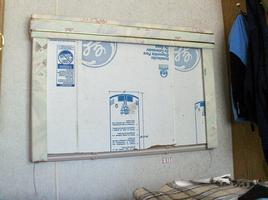
One thing that is shorter up here this time of year is the nights, or amount of darkness. It was noticeably lighter much later as we traveled north. In order to deal with the lack of darkness in the RV, we created some cardboard shades to block out the light through the windows and their blinds. This cardboard can be placed in the windows with either the brown side out or the "designer" white side out. :-) We also had to block out the light through the sklight using some aluminum foil.
Wireless internet is available at some of the RV parks along the highway. Some places it is free. Some places it costs something. Some places it works. Some places it doesn't. When it isn't available, there is usually someone in town that has an open wireless connection, sometimes purposely (ex: some coffee shops). Sara claims she can not live without checking email, so we usually did find a way for her to quickly check it most days. She also claims to not be able to live without instant messenging, but checking email is about all we do while traveling.
We have ATT-Cingular cell phones and the coverage was not all that great along the Alaska Highway. We always saw "No Service" in between towns, which was not surprising. However, we saw that also at most towns too. The places where there was coverage was using "Rogers" in Canada. We have no idea what company that is in Canada, but ATT must have some agreement with them or are related in some way. When we got to Alaska the coverage was much better, at least in towns of Tok and Fairbanks. It uses "Cellular One DCS" for the connection. On one phone call from Fairbanks to Colorado, the call was dropped about every 5 minutes. Other calls went well.
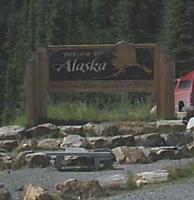
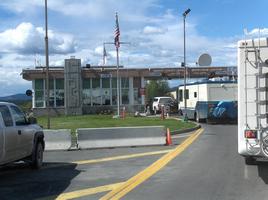 The
border crossing into Alaska went well but was very different than
when we entered Canada. This time, the lady at the customs station
asked only for our IDs, then looked at each one. She didn't ask
for or about anything else, other than noticing that we had a
dog. When she handed back the papers, she included a dog biscuit
for Sophie.
The
border crossing into Alaska went well but was very different than
when we entered Canada. This time, the lady at the customs station
asked only for our IDs, then looked at each one. She didn't ask
for or about anything else, other than noticing that we had a
dog. When she handed back the papers, she included a dog biscuit
for Sophie.